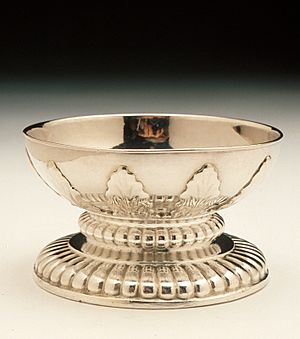Anne Tanqueray facts for kids
Quick facts for kids
Anne Tanqueray
|
|
|---|---|

Set of Four Salts, Clark Art Institute
|
|
| Born |
Anne Willaume
1691 |
| Died | 1733 Tingrith, England
|
| Nationality | English |
| Known for | Metalwork |
Anne Tanqueray (born Anne Willaume, 1691–1733) was a very talented English silversmith. She created beautiful metal items from 1724 until her death in 1733. She was known for her excellent work, especially since it was unusual for women to run their own businesses during her time.
Anne's Early Life
Anne Willaume was born in 1691. Her father, David Willaume I, was also a famous silversmith. He was a Huguenot, a French Protestant who moved to London in 1685. He came to England to escape religious problems in France.
Her Amazing Career
Anne married David Tanqueray in 1717. He was her father's apprentice, learning the silversmith trade. They had two sons together. David Tanqueray started his own workshop. It's very likely that Anne helped him make items. These items would have had her husband's special mark.
After her husband died, sometime after 1724, Anne took over the family business. She registered her own special marks at Goldsmiths' Hall. This was the place where silversmiths registered their unique symbols. It was very unusual how her marks were added. Instead of a new entry, her name was written above her husband's old mark. His name was simply crossed out. This was a unique way for a widow to take over a business.
As a female silversmith in the 1700s, Anne Tanqueray had a special chance. She could create her own designs and lead skilled workers. These workers were called journeymen. Anne's workshop was known for its very high quality. In 1729, her business became the "Subordinate Goldsmith to the King." This meant she made special items for the King!
Her Legacy
Anne Tanqueray died in 1733. She was buried in Tingrith on July 25 of that year.
You can still see examples of Anne Tanqueray's beautiful work today. Her pieces are in many important collections. These include Temple Newsam, the Huguenot Museum in Rochester, Kent, and the Victoria and Albert Museum. You can also find her work at Amgueddfa Cymru – Museum Wales, Welbeck Abbey, and the Clark Art Institute.

